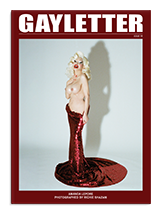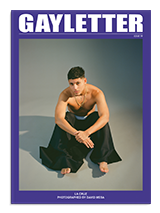
A still from the show
Fire Island
Logo's latest reality show is a farsighted look at the gay hot-spot.
Fire Island — Logo’s latest foray into queer-reality television — follows six New York gays as they spend their summer weekends on the notorious Long Island buffer.
On episode one, we meet Khasan (the house’s ring-leader), his touchy bff Jorge, and the other roommates: Brandon, Justin, Cheyenne and Patrick. Each guy is looking for different things on the island, but collectively they’d all like to have the time of their lives, or something along those lines. After all, Fire Island is a place of gay community, where gays can rejoice and be happy. The cast affirms this multiple, multiple times over the premiere. So after episode two, the question remaining is: why are they all so unhappy?
Besides Justin — the show’s token bear — all of the housemates are very typical of the Fire Island crowd. This is made blatantly clear on the commercials, which show various clips of beefy men doing anything from drinking to shouting. This is worth complaining over. A gay man knows there are several other guys in his area who are 6’3’, 174 pounds and looking to top — all he’s got to do is go on his phone. To see this kind of hyper-contextualized guy on a large and, for lack of a better word, straight-media outlet’s commercial doesn’t feel triumphant. It’s a little nauseating.
I first had the idea to watch Fire Island after the commercials came on during RuPaul’s Drag Race and my entire room of gay friends groaned with pure disdain. “Turn it off.” “God, no!” “I can’t.” You get the picture. I was just as suspect, but then I got to thinking. I’m 22 years-old. I grew up on the south shore of Long Island and have spent summers on beaches from Nassau County through Sag Habor, but never have I ever been to Fire Island. I wanted to know if my 140 lb. ass could fit in.
Growing up, my examples of gay men were from MTV’s The Real World. The gay cast member’s sexuality was always a brand new “experience” for the others. I don’t know how many confessionals a gay man cried in because his straight roommate insulted him, but it livened depressing and shameful tones inside me. I knew this could be my future.
On Fire Island, straight people aren’t making the housemates cry (at least, not yet), however it seems like just about everything else might. Episode one touches on ageism (with Brandon), body shame (with Justin) and boundaries (with Jorge). As I watched the first episode roll into the next, a wave of sorrow washed over the housemates. Khasan is bringing his boyfriend for the weekend and doesn’t want to upset Jorge who is hell-bent on having his attention. (In what seems like a bout of cute-aggression, the two wrestle each other for being difficult. Jorge reminds us that they’re a “unique” pair of friends. OK sure, let’s go with that.)
Justin worried about his body for the entire 40 minutes of episode one, but on episode two his boyfriend comes along for the weekend and alleviates any previous insecurities. He reminds us for another 40 minutes how comfortable he is now that his boyfriend is on the island.
Then there is Cheyenne. On episode one, Cheyenne only talks about how much dick is on the island. He wants to get his “drink on.” Come episode two, he’s weary of Fire Island’s entire ethos. We learn he’s just recently locked it down with some boy in Connecticut and now can’t bring himself to wear underwear to the underwear party.
Luckily there is Brandon, the 21 year-old who seems to just want to sleep around and cares significantly less than his older roommates. Patrick is also a breath of fresh air. He lives on the island all summer and presides over the house during the week like a gay shaman. He often appears out of nowhere. The roommates suspect he’s at work — I think he’s been listening from the roof.
In their own way, each housemate is quietly hoping to conquer their own idea of love and acceptance on the island. I rolled my eyes a lot while watching, but my notes told a story of complicated topics that any gay man watching will relate to. The boys are trying to behave, but no one is comfortable. Instead, Logo has edited the show down to be something of a gay Jane Austen novel – six queens with nothing to do on Long Island but fall in complicated, belligerent, sunburnt love.
On Fire Island, gay men are primary. As someone says: “This is the only place where [gay men] are in the majority.” That’s a lot of responsibility for one island, and an even larger responsibility for a television show. As the housemates’ quest for total comfort continues, I suspect it will feel cumbersome to watch considering most of us viewers are gay men who are experiencing the exact same bullshit on our own day-to-day basis.
I wonder if anything worthwhile will transpire over the show’s run. Will the masculine competitiveness flee the house? Will Brandon ever find someone willing to see past his age? Will someone besides Patrick finally wear a purse? I suppose we’ll have to keep watching to find out, but the house is a fairytale. Younger viewers are definitely not being handed moral values, and they are certainly not being handed textbook realism. Fire Island is dead set on hetero-normative requirements for reality-television: drama, sex and suspiciously accessible real estate. In short, it’s queered fantasy.
The housemates’ total fatigue, with each other and with themselves, is the realest part of the show. They seem tired of trying to abide by their friend’s standards while struggling with their own self-acceptance. It seems as though each guy would like to coop up literally anywhere besides Fire Island with a boyfriend, only to shut the doors, pour the rosé, and call it quits.
But I don’t blame them. Being gay can be exhausting. Fire Island is another reminder.


